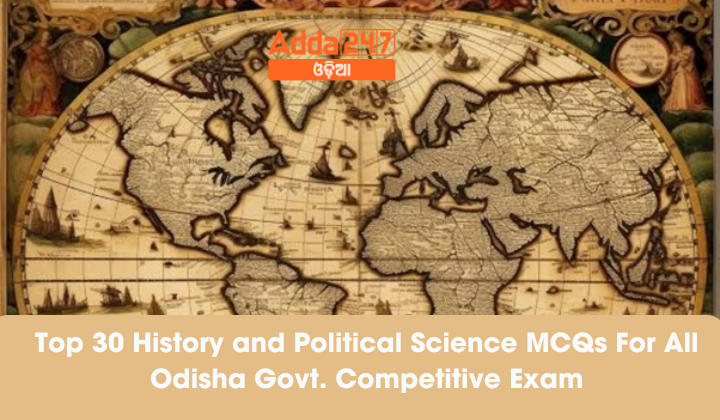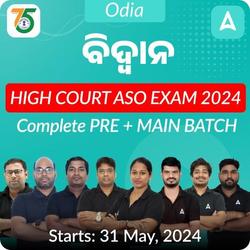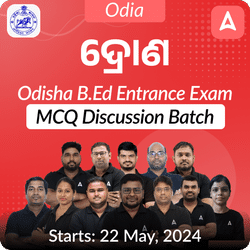History and Political Science are crucial subjects for various competitive examinations conducted by the Odisha government. These exams often include multiple-choice questions (MCQs) to assess candidates’ knowledge of historical events, political theories, and governance structures. To aid aspirants in their preparation, we have compiled a list of the top 30 MCQs covering key topics in History and Political Science. Mastering these questions will not only enhance your understanding but also boost your confidence in tackling the exam.
Top 30 History and Political Science MCQs For All Odisha Govt. Competitive Exam
- Who was one of the prominent figures associated with the Indian Renaissance during the colonial period?
a) Vasco da Gama
b) Raja Ram Mohan Roy
c) Tipu Sultan
d) Shah Jahan
Ans. b) Raja Ram Mohan Roy - Which of the following concepts was NOT introduced to Indian society during British colonization?
a) Liberty
b) Caste-based discrimination
c) Fraternity
d) Democracy
Ans. b) Caste-based discrimination - The Renaissance in India was a response to:
a) British colonization
b) Indian independence movements
c) Cultural isolationism
d) None of the above
Ans. a) British colonization - Who among the following was NOT a notable figure associated with the Indian Renaissance?
a) Raja Ram Mohan Roy
b) Dayanand Saraswati
c) Mahatma Gandhi
d) Ishwar Chand Vidyasagar
Ans. c) Mahatma Gandhi - The Indian Renaissance aimed to reform which aspects of society?
a) Religious practices
b) Social structures
c) Economic systems
d) All of the above
Ans. d) All of the above - Who was the first Governor General of India?
A. Warren Hastings
B. William Bentick
C. Lord Delhousie
D. Lord Canning
Ans. A. Warren Hastings - Who was the first Governor General of Bengal?
A. Robert Clive
B. William Bentinck
C. Warren Hasting
D. Col. Sanders
Ans. C. Warren Hasting - The first Viceroy of India was
A. Lord Canning
B. Lord Hardinge
C. Lord Dalhousie
D. Lord Elgin
Ans. A. Lord Canning - After the year 1853, a substantial amount of British capital had been invested in
A. Tea Plantations
B. The Railways
C. Coal Mining
D. Jute Mills
Ans. B. The Railways - The British Governor General and Viceroy who served for the longest period in India was
A. Lord Irwin
B. Lord Dalhousie
C. Lord Curzon
D. Lord Linlithgow
Ans. B. Lord Dalhousie - What was a significant consequence of the dissolution of the Mughal Empire?
A) Restoration of indigenous rule
B) Fragmentation of India into princely states
C) Emergence of British colonial authority
D) Establishment of a unified Indian state
Answer: B) Fragmentation of India into princely states - Which group played a pivotal role in spearheading the movement for self-determination in India?
A) British colonial administrators
B) Indian princely rulers
C) Educated elite
D) Religious leaders
Answer: C) Educated elite - What was the primary catalyst for the emergence of Indian nationalism?
A) Economic prosperity under British rule
B) Cultural assimilation by the British
C) Disparity between British interests and Indian welfare
D) Military conquests by indigenous rulers
Answer: C) Disparity between British interests and Indian welfare - Which empire left a significant imprint on India’s cultural and political landscape prior to British colonial rule?
A) Ottoman Empire
B) Mauryan Empire
C) Roman Empire
D) Mongol Empire
Answer: B) Mauryan Empire - What was the attitude of most Indians towards British colonial rule?
A) Passive acceptance
B) Enthusiastic support
C) Deep resentment
D) Indifference
Answer: C) Deep resentment - What was the primary cause of the empty treasury that King Louis XVI inherited?
a) Excessive spending on the Palace of Versailles
b) War expenses and loans
c) Inefficient tax collection system
d) Decline in trade revenue
Ans. b) War expenses and loans - How did France contribute to the American Revolutionary War?
a) By providing military aid to Britain
b) By financing British troops
c) By aiding the American colonies against Britain
d) By remaining neutral
Ans. c) By aiding the American colonies against Britain - What effect did the French assistance to the American colonies have on France’s debt?
a) Reduced it significantly
b) Had no impact
c) Increased it substantially
d) Stabilized it
Ans. c) Increased it substantially - What was the main consequence of lenders charging high interest rates on loans to the French government?
a) Increased government revenue
b) Inflation
c) Budget deficit
d) Increased social welfare programs
Ans. c) Budget deficit - Why did raising taxes fail to solve France’s financial problems?
a) The tax rates were already too high
b) Tax evasion was rampant
c) Only the 3rd estate was taxed
d) The tax system was inefficient
Ans. c) Only the 3rd estate was taxed - Which significant foundation of the Indian Constitution was drawn from the Government of India Act of 1935?
A) Fundamental Rights
B) Directive Principles of State Policy
C) Division of powers
D) Preamble
Ans. C) Division of powers - Who proudly declared that the Indian Constitution was crafted after thorough examination and assimilation of numerous global constitutions?
A) Mahatma Gandhi
B) Jawaharlal Nehru
C) Dr. B. R. Ambedkar
D) Sardar Vallabhbhai Patel
Ans. C) Dr. B. R. Ambedkar - The blend of rigidity and flexibility in the Indian Constitution is primarily manifested in its:
A) Fundamental Rights
B) Directive Principles of State Policy
C) Amendment process
D) Preamble
Ans. C) Amendment process - Which constitution exemplifies a rigid constitution?
A) Indian Constitution
B) British Constitution
C) American Constitution
D) Irish Constitution
Ans. C) American Constitution - The term “federal in form but unitary in spirit” or “quasi-federal” is often used to describe the governance structure of:
A) United States
B) India
C) United Kingdom
D) Ireland
Ans. B) India - What is the age until which Judges of the Supreme Court are assured security of tenure?
a) 60
b) 65
c) 70
d) 75
Ans: B) 65 - How can a Supreme Court judge be removed from office?
a) Simple Majority vote in Parliament
b) Special Majority through a presidential order
c) Decision by the Prime Minister
d) Referendum by the public
Ans: B) Special Majority through a presidential order on grounds of proven misbehavior and/or incapacity. - Under what circumstances can the salaries and allowances of Supreme Court judges be reduced?
a) During a financial emergency
b) Upon request by the state legislature
c) By a simple majority vote in Parliament
d) Based on the decision of the Chief Justice
Ans: A) During a financial emergency. - From where are the expenses of the High Court drawn?
a) State Legislature
b) Central Government
c) Consolidated Fund of the State
d) Chief Justice’s fund
Ans: C) Consolidated Fund of the State. - Who has the authority to expand the powers and jurisdiction of the Supreme Court?
a) State Legislature
b) President
c) Parliament
d) Prime Minister
Ans: C) Parliament
















